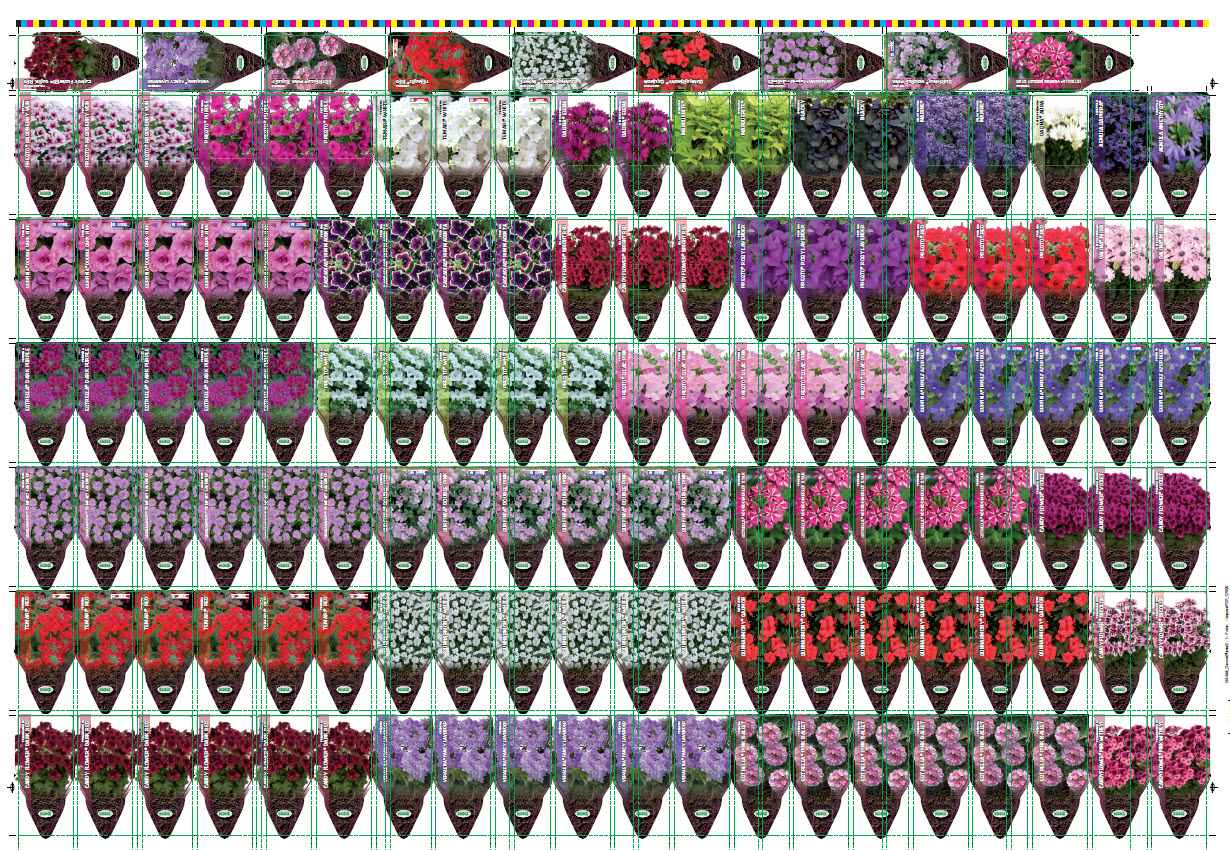
Help information for the Gangrun Portal
A gangrun-request requires following information:
1) customerID/company (login-info)
2) loginName (login-info)
3) password (login-info)
4) ProjectID (text)
5) Comment (text, may be left blank)
6) orders.csv (upload)
7) papers.csv (upload)
Production alternatives
Depending on the production-routing after printing, 3 different alternatives for cutting are available:
1) Final cutting on the guillotine-machine
2) Cutting into strokes on the guillotine-machine, followed by a stroke-cutting+punching phase on a special machine (Blumer, Polar, ...)
3) Die-cutting
Depending on the production-routing, specific parameters should be defined:
A:STANDARD WORK (no punching nor die-cutting)(=Final cutting)
To obtain impositions standard work, set the parameter punchID=0 or leave it blank. Set the parameter diecutReplicas=0.
B: PUNCHING:
Punch-work can be obtained in 2 different ways:
1) punching individual replicas (=Final cutting)
On the guillotine-machine, all replicas are cut separately, and each replica is fed individually into a punching-machine.
To obtain impositions for punching individual replicas, set the parameter punchID=0 or leave it blank.
2) punching strokes of replicas (=cutting into strokes)
To obtain impositions for punching-machines, starting from strokes, use a different unique ID for each different punch-form.
C: DIE-CUTTING:
Die-cutting-work is obtained by specifying the parameter: diecutReplicas
Order Fields
Example orders.csv (Windows: right-click with your mouse to store the file on your computer, or left-click to open it directly with Excel)
A gangrun order line should contain following fields:
- orderID
- A unique identifier for the order, e.g.: ‘A1’. All gangrunOrders must have a different orderID. This orderID should be as short as possible (e.g. 2 characters), since it is used to be visualized in the resulting drawings.
- width
- This is the (open) width of the order, bleed included, e.g. 210 mm for an A4. When the order has to be folded later on, we want here the unfolded open width.
- height
- This is the (open) height of the order, bleed included, e.g. 297 mm for an A4. When the order has to be folded later on, we want here the unfolded open height.
- Remark:
- Height and width are defined as the dimensions when holding the order in the position as for reading the text on it. All dimensions have to be specified in millimeter.
- A normal A4-order has height=297mm and width=210mm, but for a standard business-card the width will typically be larger than the height. Height and width do not correspond with the shortest or the longest dimension, as is the case for the papers.
- grainOrientation
- This is the orientation of the paper-grains in this order, as requested. Possible values are: ‘vertical’ (the grainOrientation is parallel to the height-orientation), ‘horizontal’ (the grainOrientation is parallel to the width-orientation) or ‘optimal’ (the grainOrientation may be chosen freely, in order to optimize the solution)
- copies
- The requested amount, (the run length) e.g.: 1200 copies.
- rectoColours
- These are the requested colours for the recto-side of the order. Each colour is represented by a letter: e.g.: ‘CMYK’. Spot-colors may be used e.g.: ‘CMYPK’, where another letter stands for another colour.
- versoColours
- These are the requested colours for the verso-side of the order. Each colour is represented by a letter: e.g.: ‘CMYK’. Spot-colors may be used e.g.: ‘CMYPK’, where another letter stands for another colour. For single-sided print-work, one should give here an empty string.
- customBleed
- The bleed that should be added around the order. Specifying 2mm around, will add 4mm to the width and 4mm to the height, as defined above. Set to 0 when no bleed should be added.
- cuttingPer
- This gives the number of sheets that will be cut together as 1 pile on the cutting-machine. When for example, the orders should be delivered in packages of 100 copies each, one will take exactly 100 sheets before starting the cutting-proces.
- Use the value 0 when this is of no importance. In this case, the cutting pile thickness will be the maximum thickness the cutting-machine can handle at once.
- punchID
- When rectangular orders should be punched, specific solutions may be produced as defined by the parameters for punch-work. One constraint may be for example, that orders to be punched should lie across or along in the band direction. This allows bands to be fed to a cutting+punching-machine after they have been cut by a guillotine-machine.
- Leave this string blank when the order does not need to follow the constraints for punch-work.
- Orders with different dimensions (height & width) should have different punchID's. Orders with and without punchID can be mixed.
- diecutReplicas
- The number of replicas on a sheet when using die-cutting to produce this order. Give a value of 0 to disable die-cutting.
- When die-cutting is used, all orders require the same diecutting form. This means that the same value for 'diecutReplicas' should be used for all orders. When diecutting, the dimensions of the order (height & width) are not really used. Only the value for diecutReplicas matters. An attempt is made to provide drawings, but they will only represent the correct number of replicas for each order. Nested orders will not be presented correctly in the drawings.
Remark
1) For diecutting-problems, whereby only the maximum number of replicas is given, the
produced drawings will only give an indication for the number of replicas per order. This means the number of replicas is correct, but the positioning of the replicas on the sheet is not.
Indeed, based on the given information, it is not possible to know whether and how the
replicas are nested on a sheet.
2) When a hole has be drilled first by means of die-cutting, followed by a punching phase, it is allowed to specify at the same time 'punchID' and 'diecutReplicas'. In practice however,
the correct positioning will be imposed by the die-cutting form, so a correct drawing is not
possible again.
3) When the parameter ‘diecutReplicas’ is used, the same value should be specified for all orders of the case.
4) For Workflower, ‘diecutReplicas' is the maximum number of replicas/poses on a sheet.
When one wishes to print 96 replicas on a sheet, but wants to diecut per 48 (after cutting
the sheets into 2 halfs), one should specify here 96 to obtain the best solution.
reference
Internal reference for this order as used by the MIS system.
Paper Fields
Example papers.csv (Windows: right-click with your mouse to store the file on your computer, or left-click to open it directly with Excel)
A gangrun paper line should contain the following fields:
- paperID
- A unique identification of this paper-size and type e.g.: ‘tom&otto gloss 1400*1000’. All gangrunPapers in the list of papers must have a different paperID.
- paperLength
- The longest dimension of the sheet (in mm), e.g.: 1050 mm
- paperWidth
- The shortest dimension of the sheet (in mm), e.g.: 1000 mm. The paperWidth must always be smaller than the paperLength (by definition).
Remark:
Difference between paperLength and paperWidth
PaperLength and paperWidth are determined by simply measuring the paper on the palet. Each paper-size can have it's own grainDirection, also defined versus the longest and the
shortest dimension of the paper.
WideWeb (WW) means that the grainDirection is parallel to the shortest dimension of the
paper (paperWidth), NarrowWeb (NW) means that the grainDirection is parallel to the
longest dimension of the paper (the paperLength).
PaperLength and paperWidth has nothing to do with the orientation of the paper on the
printing-press. Since the same paper may be printed as well along as across on a given
press, there exists sometimes confusion on the meaning of paperLength and paperWidth. When the sheet is printed across on the press, the length-direction of the paper
corresponds with the width-direction of the press.
- grainDirection
- graindirection of the paper ('WW’ or 'SG' = Wide Web or Short Grain, 'NW' or 'LG' = Narrow Web or Long Grain)
- pricePerKg
- price per kilogram for paper (in €/kg), e.g. : 1,2€/Kg.
- grammage
- grammage or paperweight (in g/m2), e.g.: 100 g/m2
- density
- density for the paper used, required to compute the thickness of 1 sheet on the cutting-machine (in kg/dm3), e.g.: 1,3 Kg/dm3
